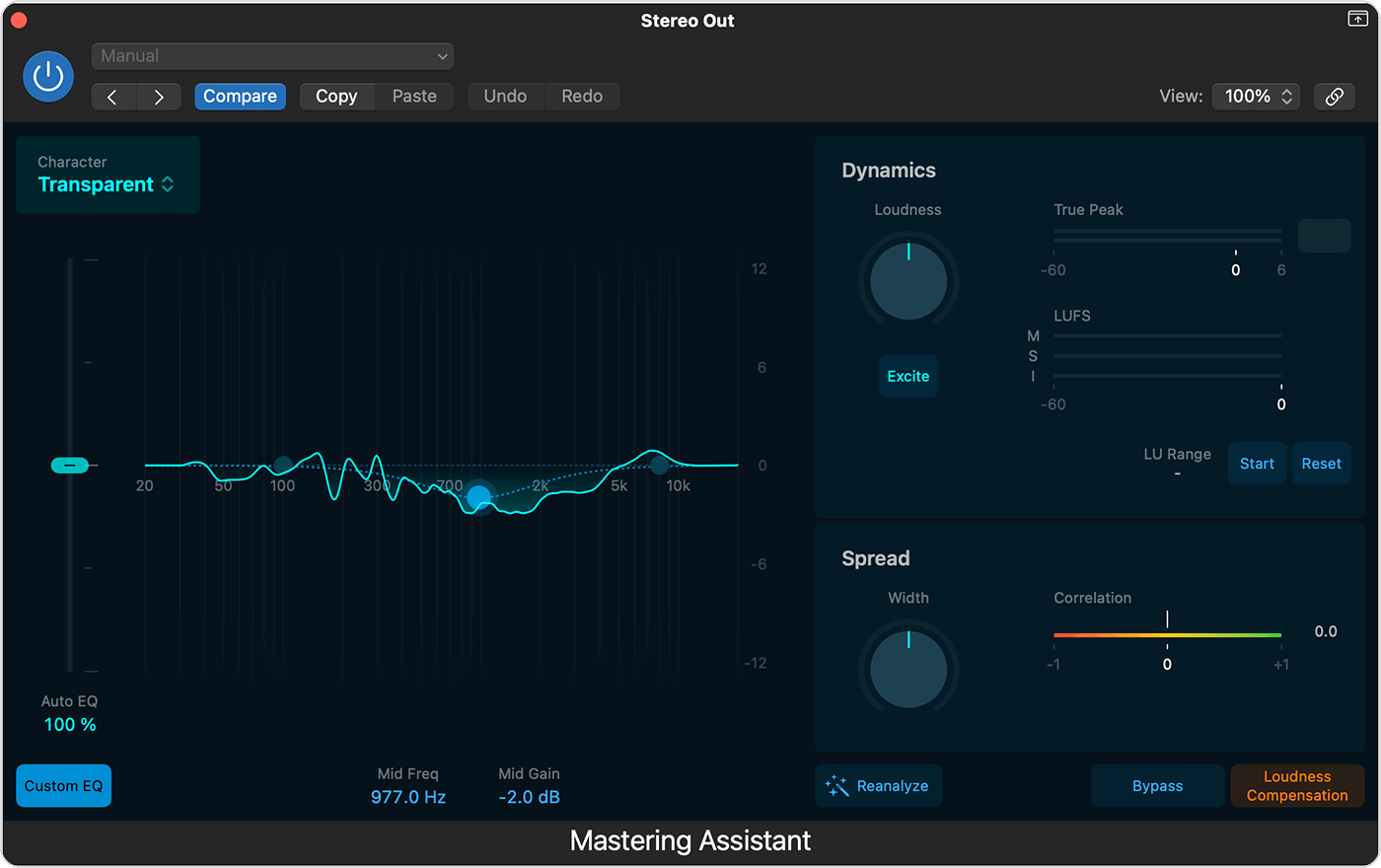Use Mastering Assistant in Logic Pro
With Mastering Assistant in Logic Pro for Mac and iPad, you can make your final mix sound great on any playback device.
Insert Mastering Assistant on the stereo output channel strip when you’ve finished your final mix down. After Mastering Assistant has analysed your audio and applied processing to your mix, you can adjust individual parameters, such as changing presets, adjusting EQ and more. When you’re satisfied with the results, bounce your mix.
Insert Mastering Assistant
Insert Mastering Assistant on the stereo output channel of your project, after any other plug-ins you may have already inserted on the stereo output channel:
On Mac, click Mastering, which is the last Audio Effect slot on the stereo output channel strip. Or Choose Mix > Mastering Assistant.
On iPad, tap the Mixer button, tap the Setup button in the toolbar of the Mixer, then tap Mastering at the bottom of the Audio Effect slot of the stereo output channel strip.

Mastering Assistant will analyse your project immediately, including all software instruments and effects. Based on its analysis, Mastering Assistant may do any of the following to your mix:
Apply corrective EQ
Adjust the loudness
Adjust the overall stereo spread
Play your project to listen to how Mastering Assistant affects your mix. To turn Mastering Assistant on and off, click or tap Bypass in the Mastering Assistant window (or toggle it on and off in the Audio Effect slot).
If you set locators, you can get Mastering Assistant to only analyse that section of your project. For example, you may want Mastering Assistant to only analyse the loudest part of your project.
Adjust Mastering Assistant
You can adjust a variety of parameters in Mastering Assistant after it has initially analysed the audio in your project. You can click Reanalyse at any point after adjusting these parameters if you don’t like the changes you’ve made.
Choose a different Character preset
When you insert Mastering Assistant initially, it will use the default Character preset called “Transparent” to process your mix. Transparent is suitable for most genres of music, and is based on classic analogue hardware mastering signal paths.
If you’re using Logic Pro on a Mac with Apple silicon or Logic Pro for iPad, you can choose different Character presets that have different sonic characteristics:
Open the Mastering Assistant plug-in window.
Click or tap the character button, then choose a preset:
For a clean yet punchy sound, choose Clean, which is designed for EDM and acoustic music.
For deep low end and refined high end, choose Valve, which is a good option for both acoustic music and hip-hop.
For an aggressive sound with a subtle emphasis on mid-range frequencies, choose Punch, which is ideally suited for rock music.
Adjust EQ
Mastering Assistant will apply corrective EQ based on its analysis of your mix. You can adjust the overall level of EQ and make manual adjustments to the EQ curve:
To adjust the overall level of EQ applied by Mastering Assistant, drag the Auto EQ slider up or down. The EQ curve in the window will change depending on how you set the Auto EQ slider.
To make manual adjustments to the EQ curve, drag any of the three control points that appear up or down to adjust the level, and to the left or right to adjust the centre point of the frequency for each EQ band. The gain rate for each EQ band is +/- 6 decibels (dB). To toggle your custom EQ curve on and off, click the Custom EQ button below the Auto EQ slider.

The spectrum analyser under the EQ curve displays the level of the frequencies across the entire frequency spectrum in real time as you play your track.
Adjust loudness and other dynamics
Mastering Assistant will adjust the loudness to optimise the perceived volume of your mix according to industry standards. You can also adjust the Loudness knob and other dynamics parameters manually:
Turn the Loudness knob to increase or decrease loudness. When the knob is in the centre position, the output of your mix will register at around -14 LUFS-I (Loudness Units, relative to Full Scale, Integrated), which is typically the target loudness for many streaming platforms. Increasing the loudness can reduce dynamics in your mix.
To more accurately compare your mix with Mastering Assistant against your original mix, click or tap the Loudness Compensation button. This can help with assessing how your mix sounds without being influenced by increased loudness. You can use the Loudness Compensation button in conjunction with the Bypass button to compare your mix with and without Mastering Assistant processing.

To add crispness to your mix, try turning on Excite. Excite adds saturation to the upper-mid range frequencies of your mix.
The Dynamics section also has metres and other tools that can help optimise the loudness of your mix.
Adjust the stereo width of your mix
Mastering Assistant will analyse the stereo width of your mix and set the Width knob accordingly. To increase or decrease the width of your mix manually, turn the Width knob. Turn the knob all the way to the left to create a mono mix that you can use to check mono compatibility.
You can use the Correlation meter to check the phase relationship of your mix. Your mix should be above zero for good mono compatibility.
Bounce your final mix
Before you bounce your mix, check this list so you get the best results:
If you’ve made any adjustments to your mix after Mastering Assistant’s initial analysis, including altering the volume or EQ on individual tracks, click Reanalyse.
Turn off Loudness Compensation.